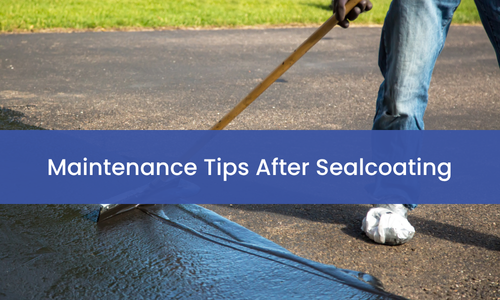If your asphalt pavement has just undergone a round of sealcoating, it will be better protected from weather, wear and the harmful UV rays from the sun. To get the most out of your asphalt sealcoat there are some easy maintenance tips that any property owner can follow after sealcoating. Those tips include:
- Giving the sealcoat curing process enough time before using the asphalt pavement
- Removing any debris or stains from the pavement surface as soon as possible
- Ensuring the pavement is draining quickly and that water isn’t pooling on its surface
- Preventing plants from rooting close to the asphalt
- Repairing any cracks in the asphalt pavement once they emerge
- Partnering with a proven pavement company for asphalt sealcoating services
By following the above maintenance tips, property owners will maximize the protective qualities of any applied asphalt sealcoat – whether it is for a parking lot, a road, a walkway or another piece of pavement.
Six Maintenance Tips to Follow After Asphalt Sealcoating
Have you just had your asphalt sealcoated, or are planning to do so soon? If so, follow these six maintenance tips to get the most from your new layer of sealcoat:
- Allow time for the asphalt sealcoat to cure before using the pavement – Curing is an integral part of the sealcoating process, imparting the strength and stability into the asphalt to improve its protective qualities. Curing is also a part of the process you do not want to interfere with, as this may mitigate any advantages realized by the sealcoating.
In general, asphalt sealcoating cures quickly, especially if there is enough ambient heat to facilitate the process. As long as temperatures are 60 degrees or higher, it will take about 24 hours for the sealcoat to cure, but it will take longer if temperatures drop enough. During the curing process, do not walk or drive on the asphalt for the best results.
- Remove debris and stains from the asphalt pavement as soon as possible – It is always a good idea to keep your asphalt parking lot or road debris- and stain-free, but it is even more important following a round of sealcoating. Any debris or stains that sit on the pavement surface during curing will damage the sealcoat’s integrity. As such, remove any large bits of debris and any spills (oil, etc.) as soon as you can.
- Ensure adequate drainage is in place prior to sealcoating – It will be too late to address your asphalt’s drainage after the sealcoating is in place, so ensure that it is up to the task before investing in a round of maintenance.
If water is standing on your asphalt surface, that can be a major red flag. If standing water is present, it is time to bring in an expert pavement contractor to identify the underlying cause and recommend a solution. For example, if your property’s existing drainage structures are not sufficient for runoff volumes, then additional infrastructure may need to be installed, such as drainage ponds, curb and gutter systems, catch basins and culverts. It could also be a matter of removing any unstable asphalt and stabilizing the base before moving forward with other maintenance.
- Prevent plant growth from establishing close to the asphalt – Plants grow slowly but strongly, eventually working into any material they have time to infiltrate. This includes asphalt pavement as vegetation can split it open and cause it to fracture at the edges. If the asphalt has just been sealcoated, you will get more out of your investment by keeping the weeds and tree roots away from the pavement.
Repair cracks as soon as it is feasible to do so – Not every asphalt crack needs to be addressed, but many do. Expert asphalt contractors seal asphalt cracks with a form of rubberized asphalt that is melted and deposited into each crack. Once cured, the crack filler will provide a watertight seal that remains flexible as thermal stresses cause the asphalt pavement to swell and shrink.
If you notice cracks forming in your asphalt, schedule an inspection with an asphalt company. If the cracks are considered to be a threat to the asphalt in general (usually via water intrusion), then get them repaired before damage to the pavement’s deeper layers compromises the asphalt sealcoating.
- Partner with a proven asphalt company for your sealcoating services – Your asphalt is an investment, so it is important to work with experts who really know asphalt. Asphalt sealcoating must be applied evenly and at sufficient thickness to achieve the desired results. Many contractors apply asphalt sealcoating in two thinner layers to promote faster and more complete curing. Pavement experts pick up efficiency and quality techniques like this from decades of practice on the job, and there is no substitute for experience. Your asphalt sealcoating team should also have this experience to draw from.
- Allow time for the asphalt sealcoat to cure before using the pavement – Curing is an integral part of the sealcoating process, imparting the strength and stability into the asphalt to improve its protective qualities. Curing is also a part of the process you do not want to interfere with, as this may mitigate any advantages realized by the sealcoating.
Asphalt Sealcoating Will Extend Your Pavement’s Life, and Maintenance Will Extend Your Sealcoating’s Life
Sealcoating your asphalt is an essential, fundamental part of pavement maintenance, and will ensure your asphalt remains viable for much longer. From a cost efficiency standpoint, it is an easy choice.
- Why Should Asphalt Maintenance in Houston be a Priority for Property Owners? - November 14, 2025
- What Factors Determine the Cost of Asphalt Services in Houston? - October 23, 2025
- What Services Do Houston Road Contractors Offer? - October 16, 2025

